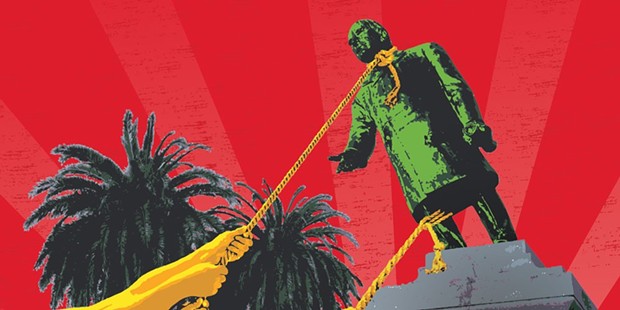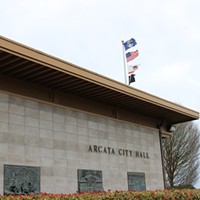Top 10
The North Coast's most impactful stories of 2018
By Thadeus Greenson [email protected] @ThadeusGreenson and Kimberly Wear [email protected] @kimberly_wear[
{
"name": "Top Stories Video Pair",
"insertPoint": "7",
"component": "17087298",
"parentWrapperClass": "fdn-ads-inline-content-block",
"requiredCountToDisplay": "1"
}
]
A new year should be seen as a time of hope, a chance to pause, reflect and to set our sights on becoming better people and a better community. When we look back on 2018, we recall times of intense division — we squabbled over land uses, political campaigns, recovery services and criminal justice. There have also been triumphs, moments of unity and forward progress. These themes are all evident here in our list of 2018's most impactful stories. It wasn't an easy list to cull down and there were plenty of worthy topics — massive changes to Humboldt County's judicial bench, the tantalizing promise of offshore wind energy and Eureka's monumental steps toward returning Indian Island to the Wiyot Tribe, just to name a few. So as you read our list, reflect on 2018 and tell us what we missed. A decade or two from now, how will you remember 2018 in Humboldt County?
Legalization Arrives
Humboldt County's first legal recreational weed customer, which is a bit ironic, as she doesn't even smoke. She told theThe day Humboldt County has long hoped for and feared came Jan. 1, 2018, when for the first time people over the age of 21 could legally buy cannabis for recreational use. There was a jovial atmosphere in Eureka's Old Town as a line began forming in front of EcoCann — the only local dispensary that was poised to operate New Year's Day — two hours before the doors were set to open. History will remember Laura Montagna as Humboldt County's first legal recreational weed customer, which is a bit ironic, as she doesn't even smoke. She told the Journal she just thought it would be "historic and cool" to buy Humboldt's first legal bag. Dispensaries throughout the county have been humming ever since, dolling out buds, concentrates and edibles with little more fanfare than your local liquor store.
But legalization has also brought significant impacts. Local farmers are struggling to make ends meet in the face of steep compliance costs, state and local taxes, testing and distribution fees, and statewide market forces. Margins for those still operating on the black market, meanwhile, continue to decline as per-pound prices continue their freefall. While there has been a boost in legal cannabis industry employment, the consensus is legalization is hitting the local economy hard. Some businesses have shuttered and many more report they're struggling to remain open amid declining sales and sluggish traffic. The local industry has also seen some hefty, targeted investment, with outside companies dumping millions into purchases or partnerships with North Coast cannabis farmers and manufacturers.
The North Coast's cannabis culture is also shifting as the industry continues to step out of the black market shadows, with even the Eureka-Humboldt Visitor's Bureau beginning to market the county as a cannatourism destination.
Where this road leads remains unclear. But whether we look back on legalization as the beginning of another economic bust cycle for Humboldt County or the moment when a legal, sustainable economic driver took root, we'll likely look back on 2018 as the year when everything changed.
Coastal Crisis
First there was an outbreak of toxic algae off Sonoma County in 2011. Then, two years later, sea stars up and down the coast suddenly began dying from a mysterious wasting disease, opening the door for sea urchins — now free of their main predator — to lay waste to the region's rocky reefs.
Amid these already shaky conditions, the so-called "warm blob" descended on the scene in 2014, heating up the region's normally chilly ocean waters. The "Godzilla" El Nino followed in its wake.
Put together, this series of climatic events produced what scientists have described as a "perfect storm" that, in just a few short years, wracked havoc on the ocean environment, leaving bull kelp forests across the region decimated and, in turn, the abalone to starve.
This rapid decline of the abalone stocks led to last year's unprecedented decision by the California Fish and Game Commission to shut down the recreational season for a year.
Earlier this month, with no signs of a rebound on the horizon, that closure was extended to 2021, leaving coastal communities like Fort Bragg — which depend on the recreation divers who traditionally made annual pilgrimages to their shores — facing economic losses of an estimated $26 million, with up to 250 jobs on the line.
While there are a few bright spots, like Humboldt's own Trinidad Bay, where kelp and abalone — at least so far — appear to be holding steady, the plight of the abalone is just one of the fisheries causing worry.
The commercial Dungeness crab season has once again been postponed, this year due to a lack of heft in the local crustaceans, and local salmon runs have also been poor recently, with the Yurok Tribe canceling its commercial season for the third year in a row, a decision the tribe described as "devastating to the Yurok people, who depend on fall Chinook salmon for financial security, subsistence and ceremony."
Countdown on McKinley
Exactly 118 years after President William McKinley was elected to his second term in office, the voters of Arcata cast their ballots against an effort to keep a monument of his likeness in the city's plaza.
The last Civil War veteran to serve as commander in chief, McKinley would be assassinated less than a year after his reelection in 1901, which led Arcata farmer George Zehndner to commission the statue for his city, the first major work by renowned Armenian sculptor Haig Patigian.
Zehndner paid $15,000 for his homage to the nation's 25th president, whom he reportedly revered, a sentiment apparently cemented after he saw McKinley when the president visited San Jose shortly before his death.
Over the years, there has been debate, often heated, about whether the bronze work was an appropriate fit for such a prominent placement in the city. But a recent removal effort gained momentum in 2018 amid a backdrop of other cities across the nation grappling with how to confront bleak chapters of the past represented by historic landmarks still standing in the present.
The McKinley statue debate culminated in a contentious and at times combative February meeting when a majority of city council members voted that it was time for the monument that had barely survived the Great San Francisco earthquake of 1906 to be removed from the plaza's center.
Councilmember Michael Winkler was on the lone end of the 4-1 vote that night and later caused some controversy of his own by penning an open letter to then Mayor Sofia Pereira, writing that he was "appalled by the lynch mob/vigilante atmosphere" and the "extreme self-righteousness and harassment and intolerance for people expressing an unpopular point of view."
At one point, Councilmember Susan Ornelas threw a wrench into the process by putting forward — then rescinding — a proposal to put the matter to a public vote after yet another quarrelsome meeting in the still raw aftermath of the February vote.
In response, Measure M was brought forward via the citizen initiative process and sought to block the move by asking voters to decide whether to prohibit the city from allowing the "modification, destruction, relocation" of McKinley's statue or its base from the plaza center.
But the initiative fell flat on Election Night, with 68 percent of those who cast a ballot voting against changing course on the council's decision.
Now, because the McKinley statue is listed as a historic feature of the plaza in the Arcata General Plan, an environmental review is underway for the removal, which is expected to begin in 2019.
Seeking Sanctuary
Like many across the nation who were aghast to see the American government separating children from their parents at the border, many of whom were seeking asylum from dangerous conditions in Central America, Humboldt County residents took to the streets this summer in protest.
The diverse group stretched the better part of three blocks as it made its way through Eureka's Old Town in a peaceful pushback to the Trump administration's policy, demanding that families be reunited.
For some in the crowd, the issue was intensely personal.
At the time, Claudia Portillo — a 33-year-old mother of four American-born children who had been brought to the U.S. from El Salvador when she was a young girl — was being detained, taken into custody by immigration officials after showing up for a regular check-in in San Francisco.
There was a time she would not have been on ICE's radar, let alone locked up for seven months until her community was able to raise the $12,000 bond set by an immigration judge.
While Portillo was finally allowed to return home to her children, the youngest of whom was 6, after missing Christmas, birthdays, her eldest daughter's high school graduation, the detainment had already taken a devastating toll on the family.
All of her savings had gone to maintaining the family's bills but, more than anything, the strong maternal bond she had with her children had been irrevocably frayed.
"I was living a perfect life," Portillo told the Journal in July. "My girls were living a perfect life and we were doing so good. I mean, I'm not going to tell you it was perfect-perfect but we really were doing good. And then this happened and I can't just sit here and blame anyone else but the system."
But residents of Humboldt County didn't stop with a march when it came to issues of immigration.
In November, Measure K was approved by 55 percent of voters, making Humboldt a "sanctuary" county, barring county employees from coordinating with U.S. Immigration and Customs Enforcement in almost all cases despite dire predictions of what such an effort would cost.
While most of the 2,500 children taken from their parents at the border have been reunited, the federal government was partially shut down amid a standoff over funding Trump's border wall as the Journal went to press, ensuring the immigration debate will continue into 2019 and beyond.
Justice for Josiah
Ever since he was stabbed to death at an off campus party April 14, 2017, 19-year-old Humboldt State University sophomore David Josiah Lawson's story has commanded Arcata's attention.
As 2018 began, frustrations were mounting in the community as there were few outward signs the Arcata Police Department's investigation into Lawson's death was progressing. Pressure increased with monthly vigils and protests as the anniversary of Lawson's death loomed. On April 9, Tom Parker, a retired FBI agent the city had brought in to consult on the murder investigation, stepped down, telling the Journal that APD had lied to him about the investigation and was disregarding his advice. Less than 24 hours later, Police Chief Tom Chapman resigned without notice. Within a week, Lawson's mother, Charmaine Lawson, had filed a claim for damages against the city, alleging APD had botched the investigation into her son's slaying.
In August, protesters filled city council chambers, promising to disrupt the city's meetings and prevent the council from carrying out other city business until progress was made in the homicide investigation. After a pair of meetings were adjourned early, APD Interim Chief Richard Ehle told assembled protesters that APD was making steady progress on the investigation, having allocated additional resources and brought in outside investigators to aid the probe. In fact, Ehle said, he expected to have the case ready to turn over to the district attorney's office within a couple of months.
In November, APD officially submitted the case to the Humboldt County District Attorney's Office for review, with Ehle telling the Journal the investigation had found "unequivocal physical evidence" that linked a specific suspect to Lawson's death. As 2018 came to a close, District Attorney Maggie Fleming was still reviewing the case file in an effort to determine whether to file criminal charges, all but ensuring Lawson's killing and its aftermath will remain focal points in 2019.
The Sentencing of Marci Kitchen
The 14-year-old girls had been dead for more than two years when Marci Kitchen stood before Judge Kaleb Cockrum in September and was sentenced to eight years in prison for killing her daughter Kiya Kitchen and her daughter's friend Faith Tsarnas.
It was the middle term she could have received for fleeing the scene after striking the teens from behind while they skateboarded down Eel River Drive on July 12, 2016. Tsarnas died at the Fortuna crash site and Kiya Kitchen's death followed a day later at a Bay Area hospital where she had been flown for treatment of her extensive injuries.
Kitchen's attorney had asked the judge for probation in the case, while the prosecution asked for what the district attorney's office calculated to be the maximum possible term, 11 years and four months, after Kitchen surprised everyone by pleading guilty as charged as her trial approached.
Many in the community were incensed that a mother could not only leave two fatally injured girls alone on the roadside but then spend the ensuing 24 months out of jail while her case wound its way through the judicial system due to numerious delays.
Before learning the term she would face, Kitchen first heard about the anger and grief carried by the girls' friends and family and the devastation they felt upon hearing the news of what had happened on that summer's night.
Those included her son, Kiya's older brother Jevin Kitchen, who told the court that he not only lost a sister that night, he also lost his mother.
"I don't want her to be part of my life in any way, shape or form," he told Cockrum, not looking in his mother's direction as she sobbed. "Every time I hear her name or see her picture, it hurts my soul."
Divisions Widen in Eureka
Eureka had itself quite a year in 2018. On the one hand, the "Queen City of the Ultimate West" took some steps to give itself a bit of a makeover — nothing major, just a bit of blush and eye shadow. First, the city launched its Eureka Box Art program, which gave artists $500 apiece to refashion utility boxes throughout town into mini murals. While the program has transformed scores of boxes from street-side eyesores into pieces of art ranging from whimsical to beautiful, it was not entirely without controversy, as one business owner pitched a fit about the design of a box near her spa, igniting widespread backlash. (The box was ultimately whitewashed and repainted as an homage to Bigfoot, while the original design was replicated elsewhere.)
On a larger scale, the city held its first Street Art Festival, which saw more than 20 local and visiting artists spend a week transforming bland walls along Old Town's Opera Alley (plus another on Fifth Street) into vibrant murals.
But amid the city's innovative attempts to beautify, a nasty controversy broke out surrounding a particular type of litter — used syringes. Fed up with finding the refuse from the city's growing heroin and methamphetamine epidemics in rain gutters, parks and public bathrooms, some placed the blame squarely on the shoulders of the Humboldt Area Center for Harm Reduction (HACHR), a nonprofit that offers needle exchange service within the city.
The conversation around HACHR turned downright toxic, with threats of violence and misinformation bouncing around social media. The issue came to a head in city hall July 17, when members of the city council openly questioned whether the city could continue to work with the nonprofit, which had become the most hated entity within city limits in some circles. Ultimately, the council decided a month later to stay the course with HACHR, pointing to the city's high rates of hepatitis and HIV as evidence of its need. Some members of the public promised retribution at the ballot box in November, but incumbents who supported HACHR's work within the city cruised to re-election. And in October, HACHR received state authorization, which it said would allow it to increase its hours of operation and the breadth of its services.
Elections Bring New and Familiar Faces
Elections in Humboldt County are rarely boring and the 2018 contests of June and November proved to be no exception.
Take the early-morning after election night moment — around 12:40 a.m. — when results suddenly flipped to show challenger Steve Madrone had erased two-time incumbent Ryan Sundberg's 185-vote advantage and was now leading the race to become the county's Fifth District supervisor.
Then the waiting game began, at least for election watchers, with the two candidates separated by just a fraction of the votes cast.
This was a hard-fought race, with allegations thrown by each side of the contest at one point or another. In the end, Madrone would come out ahead by 118 votes in the nail-biter, with Sundberg conceding the race a month later, congratulating the victor in an email "on a tough election and ultimate victory."
But that paled in comparison to the surprisingly dramatic auditor-controller race between the ultimately successful Karen Paz Dominquez and Mike Lorig.
In the run-up to the June ballot, Paz Dominguez — who is serving as assistant auditor-controller until taking office in January — shook things up a bit by speaking out about inter-office power struggles, a sexual harassment complaint against her former boss and several breaches of confidential personnel information.
Meanwhile, things got a little rancorous over in Eureka, too, during the November General Election, with several of the 12 hopefuls banding together at one point to call for civility in the mayor's race and three council contests.
In the end, money didn't always translate to a seat at the dais as the city got into the swing of its first true ward election since the Prohibition era. Despite an attempted pushback by some on the council's current direction, incumbents Kim Bergel and Natalie Arroyo sailed back into office and, along with political newcomers Mayor Susan Seaman and Councilmember Leslie Castellano, were just sworn in for a new term.
Students Protest Gun Violence
At 10 a.m. on March 14, hundreds of students throughout Humboldt County walked out of class for 17 minutes, standing in solidarity with students at Marjory Stoneman Douglas High School in Parkland, Florida, with each minute representing one of the 14 students and three adults killed in a mass shooting there on Feb. 14. A week later, hundreds of students and community members braved the rain to march in Arcata to protest gun violence.
At the walk outs, march and in a package of op-eds penned for the Journal, the students said loudly and unequivocally that they don't feel safe and demanded action to stem the growing tide of school shootings and the larger national epidemic of gun violence.
A pair of local students — North Coast Preparatory Academy freshmen Eva Swartz and Oliva Joachim — didn't stop with protest. They showed up at a May 2 Arcata City Council meeting and urged the city to amend its municipal code to include a firearm storage ordinance, citing statistics showing that "70 percent of deaths related to child shootings could have been prevented if the firearm was locked and safely stored." On Oct. 17, the Arcata City Council answered the students' call, passing an ordinance requiring gun owners to keep their firearms locked up when not at arm's reach. Nationally, 2018 will be remembered in part as the year students took a stand against gun violence but local students accomplished something their national counterparts have so far been unable to do: spur changes in gun control laws.
HSU Football Gets Axed
As 2017 came to a close, Humboldt State University football fans were ebullient, still celebrating a Hail Mary fundraising effort that had saved the program. As it would turn out, upon further review, the Hail Mary was ruled incomplete.
After HSU President Lisa Rossbacher announced that the program was on the chopping block last year, a community-led fundraising effort garnered millions of dollars in pledges — enough to cause Rossbacher to announce the program had been saved. The good news kept rolling in when the Tampa Bay Buccaneers took standout Lumberjack center Alex Cappa in the second round of the National Football League draft, making him the first HSU player selected in the draft in more than 25 years.
The celebration proved to be short lived. In July, Rossbacher reversed course, announcing that 2018 would be HSU's last football season as community members had failed to follow through on pledged donations, leaving the program $170,000 short of its fundraising goal for 2018.
The nearly century-old program then limped through its final season — the uncertainty having taken a toll on recruitment and retention efforts — and finished with a 2-8 record on the year that included a heartbreaking home finale. (Despite the loss, the game, it should be noted, came with a happy ending as senior lineman Nathan Trent proposed to his girlfriend on the field afterward. She said yes.)
The program's shuttering leaves Azusa Pacific University as California's only Division II school with a football team.
Speaking of...
More by Thadeus Greenson
-
Seeking Salvation
'Living in amends,' a candidate for resentencing hopes for another chance
- Apr 18, 2024
-
UPDATE: Artillery Shell Deemed Safe in Ferndale
- Apr 12, 2024
-
Turning the Titanic
Cal Poly Humboldt recognized for leadership in addressing global plastics crisis
- Apr 11, 2024
- More »
More by Kimberly Wear
-
Dust to Dust
The green burial movement looks to set down roots in Humboldt County
- Apr 11, 2024
-
Our Last Best Chance
- Apr 11, 2024
-
Judge Rules Arcata Can't Put Earth Flag on Top
- Apr 5, 2024
- More »
Latest in News
Readers also liked…
-
Through Mark Larson's Lens
A local photographer's favorite images of 2022 in Humboldt
- Jan 5, 2023
-
'To Celebrate Our Sovereignty'
Yurok Tribe to host gathering honoring 'ultimate river warrior' on the anniversary of the U.S. Supreme Court ruling that changed everything
- Jun 8, 2023














































